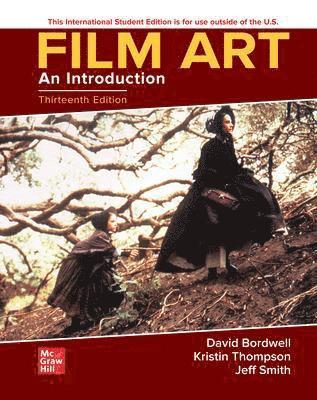
- Format
- Häftad (Paperback)
- Språk
- Engelska
- Antal sidor
- 544
- Utgivningsdatum
- 2023-10-13
- Upplaga
- 13
- Förlag
- McGraw Hill
- Medarbetare
- Thompson, Kristin / Smith, Jeff
- Illustratör/Fotograf
- unspecified 15 Illustrations
- Illustrationer
- 15 Illustrations, unspecified
- Dimensioner
- 20 x 275 x 214 mm
- Vikt
- Antal komponenter
- 1
- ISBN
- 9781265205478
- 1082 g
Film Art: An Introduction ISE
- Skickas från oss på tisdag
- Fri frakt över 249 kr för privatkunder i Sverige.
Passar bra ihop
De som köpt den här boken har ofta också köpt Finance : markets, instruments & investments av Hans Byström (häftad).
Köp båda 2 för 1222 krKundrecensioner
Fler böcker av David Bordwell
-
The Way Hollywood Tells It
David Bordwell
-
Minding Movies
David Bordwell, Kristin Thompson
-
The Classical Hollywood Cinema
David Bordwell, Janet Staiger, Kristin Thompson
-
The Rhapsodes
David Bordwell
Övrig information
David Bordwell is Jacques Ledoux Professor Emeritus of Film Studies in the Department of Communication Arts at the University of WisconsinMadison. He also holds a Hilldale Professorship in the Humanities and an Honorary Doctorate from the University of Copenhagen. He has also held the Kluge Chair in Modern Culture at the Library of Congress. His books include Narration in the Fiction Film (University of Wisconsin Press, 1985), On the History of Film Style (Harvard University Press, 1997), Planet Hong Kong: Popular Cinema and the Art of Entertainment (Harvard University Press, 2000; 2nd ed., Irvington Way Institute Press, 2011), Figures Traced in Light: On Cinematic Staging(University of California Press, 2005), The Way Hollywood Tells It: Story and Style in Modern Movies (University of California Press, 2006), The Rhapsodes: How 1940s Critics Changed American Film Culture (University of Chicago Press, 2016), and Reinventing Hollywood: How 1940s Filmmakers Changed MovieStorytelling (University of Chicago Press, 2017). He has also written books on Carl Theodor Dreyer, Yasujiro Ozu, Sergei Eisenstein, digital cinema, and Hong Kong film.
Kristin Thompson is an Honorary Fellow in the Department of Communication Arts at the University of WisconsinMadison, where she earned her Ph.D. Her books include Eisensteins Ivan the Terrible (1981), Exporting Entertainment: Americas Place in World Film Markets 19011934 (1985), Breaking the GlassArmor: Neoformalist Film Analysis (1988), Storytelling in the New Hollywood:Understanding Classical Narrative Technique (1999), Herr Lubitsch Goes to Hollywood: German and American Film after World War I (2005), and The FrodoFranchise: The Lord of the Rings and Modern Hollywood (2007).
Jeff Smith is a Professor of Film Studies in the Department of Communication Arts at the University of WisconsinMadison, where he earned his Ph.D. He is the author of two books: The Sounds of Commerce: Marketing Popular FilmMusic (1998) and Film Criticism, the Cold War, and the Blacklist: Reading the Hollywood Reds (2014). He has also published several articles and book chapters on the role of sound and music in American cinema. He is currently at work on a book that traces development of the classical Hollywood film score during the 1930s that examines how studios allocated musical resources to films based on their position within the hierarchy of prestige pictures, programmers, and B films.
Innehållsförteckning
About The Authors
Preface
part one film art and filmmaking
CHAPTER 1 Film as Art: Creativity, Technology, and Business
part two film form
CHAPTER 2 The Significance of Film Form
CHAPTER 3 Narrative Form
part three film style
CHAPTER 4 The Shot: Mise-en-Scene
CHAPTER 5 The Shot: Cinematography
CHAPTER 6 The Relation of Shot to Shot: Editing
CHAPTER 7 Sound in the Cinema
CHAPTER 8 Summary: Style and Film Form
part four types of films
CHAPTER 9 Film Genres
CHAPTER 10 Documentary, Experimental, and Animated Films
PART FIVE Critical Analysis of Films
CHAPTER 11 Film Criticism: Sample Analyses
PART SIX Film Art and Film History
CHAPTER 12 Historical Changes in Film Art: Conventions and Choices, Tradition and Trends
Glossary
Index
Optional Chapters (available through Create and Connects ebook)
Film Adaptations (supported by SmartBook)
Writing a Critical Analysis of a Film
Additional Resources for Film As Art: Creativity, Technology, and Business
Du kanske gillar
-
Rivals
Jilly Cooper
Häftad -
Deep Work
Cal Newport
Inbunden


